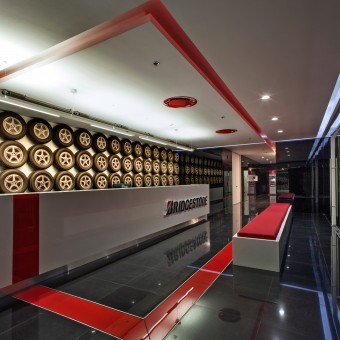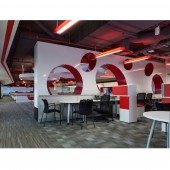Bridgestone Corporate Offices by Juan Carlos Baumgartner |
Home > Winners > #31854 |
 |
|
||||
| DESIGN DETAILS | |||||
| DESIGN NAME: Bridgestone PRIMARY FUNCTION: Corporate Offices INSPIRATION: The use of reflecting materials creates a distinctive feeling of immersion that connects the user to the brand. The perfectly distributed floor separates public areas from operating areas, reflecting through architecture the very essence of the company. UNIQUE PROPERTIES / PROJECT DESCRIPTION: Its design was inspired in functionality to increase productivity, as well as in movement, dynamism and light in motion. All this was achieved through the use of rugs and lighting that emulate the blur effect of cars in motion. OPERATION / FLOW / INTERACTION: A dynamic space that invites you in. A black reception to indicate just that moment before you accelerate. An open space that resembles speed, the way you look at things and lights when you are driving fast a car. PROJECT DURATION AND LOCATION: DATE: February - November, 2013 LOCATION:Polanco-Lomas, Mexico City FITS BEST INTO CATEGORY: Interior Space and Exhibition Design |
PRODUCTION / REALIZATION TECHNOLOGY: We use Shaw carpet tile, real tires that became swings and lounges, a lot of glass to help make a very lighted space. Few materials to make a much more cleaner space. SPECIFICATIONS / TECHNICAL PROPERTIES: This project is developed on a single floor of about 2300 sqm. TAGS: llantas, tires, bridgestone mexico, swings, golf, golf balls wall, speed RESEARCH ABSTRACT: Possibly the most important challenge in the design process of a new space is the ability to align space and business. This alignment requires specific methodologies to identify the goals and objectives of an organization and generate a diagnostic of how space can be a tool in the pursuit of success. Space has developed a unique methodology that is designed to generate this strategic alignment. The Discovery session brings together the heads of the organization and using two diagnostic card games are determined on one hand the most important concepts related organization: Economic Value Attraction and retention Organizational Culture Corporate Identity The second set of cards is called brandspAce, it focuses on determining the emotional profile of the organization. In a world that increasingly generate experiences about a brand becomes a determining factor, define what emotions represent the organization is essential. As a result of this phase space given a diagnosis on what document will have a series of recommendations that can be used later in the design and development of the project. Based on what is known in the United States as "Social Learning Theory", it is the result of a series of studies that have demonstrated that around 50 percent of what a person learns is learned in social environments. These studies and all the literature resulting from them have generated the doubt as to whether the spaces in which we have been educated for decades really respond to the manner in which human beings learn and whether organizations have designed spaces that promote learning. The majority of the challenges that we will face as a society will generate the need to rethink many things: how we educate ourselves, how we work and, in general, how we live. These questions will result in the immediate need to create more innovative, more empathetic solutions that respond adequately to the challenges we face. This is generating the opportunity to redesign our society, our educational systems, our economies, our cities. For decades we have seen how design has been limited to spaces and objects, but that manner of designing is going to change: everything can be designed, from services to experiences, passing through complete processes and communities. The concept of Evidence Based Design or EBD for its initials in English, is a field of study emphasizing the generation of evidence of how the design affects the users of a space. EBD will become the methodology par excellence in the design of spaces for health, seeking to improve the health of patients and reduce the stress of caretakers and relatives. Paradoxically, the delayed development of Mexico and some Central American countries offers us the opportunity to apply new strategies in the design of spaces for health that at another time would not have been available, such as the case of EBD. In 2014 we will see that these countries will begin to apply a design based on evidence to create a new generation of spaces for health in which the architecture will be a fundamental component. CHALLENGE: According to Steven Johnson all the intellectual revolutions in the history of humanity have been linked to physical environments that were able to interconnect people in environments that made it possible to construct ideas around one another’s thoughts. And thus a transcendental question arises this year: if our brain and the natural generation of ideas function like that. ADDED DATE: 2014-01-08 11:18:02 TEAM MEMBERS (17) : ARCHITECTURAL DESIGN: , SPACE, Juan Carlos Baumgartner, Jimena Fernández Navarra, Sinuhé Vera Montes de Oca, , COLLABORATORS:, Lorenzo Pierini, , LIGHTING DESIGN:, LUA, , , CONSTRUCTOR:, GA&A, FURNITURE: Teknion and PHOTOGRAPHY: Paul Czitrom IMAGE CREDITS: Paul Czitrom |
||||
| Visit the following page to learn more: http://spacemex.com/ | |||||
| AWARD DETAILS | |
 |
Bridgestone Corporate Offices by Juan Carlos Baumgartner is Winner in Interior Space and Exhibition Design Category, 2013 - 2014.· Read the interview with designer Juan Carlos Baumgartner for design Bridgestone here.· Press Members: Login or Register to request an exclusive interview with Juan Carlos Baumgartner . · Click here to register inorder to view the profile and other works by Juan Carlos Baumgartner . |
| SOCIAL |
| + Add to Likes / Favorites | Send to My Email | Comment | Testimonials | View Press-Release | Press Kit |
Did you like Juan Carlos Baumgartner's Interior Design?
You will most likely enjoy other award winning interior design as well.
Click here to view more Award Winning Interior Design.








